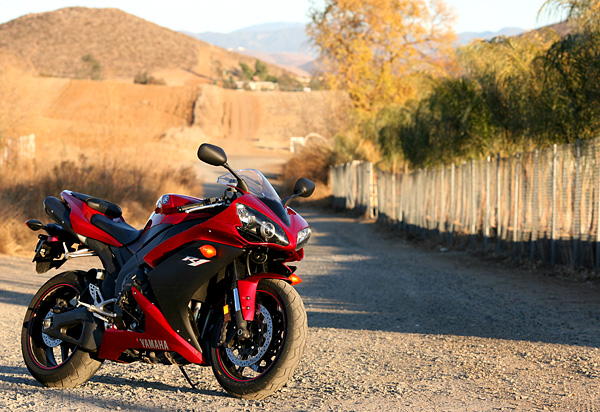
When Yamaha’s engineers set out to redesign the successful 2005-2006 R1, they gave themselves a tall order: take a bike that was considered an excellent track weapon, with sharp handling and great high-rpm power, and not just maintain but improve those strong points, while at the same time making significant advances in the bike’s weak areas: low-rpm power and overall streetability. Not only that, but their efforts to increase engine power had to make an end-run around the changes they HAD to make to meet new, stricter emissions regulations. Quite a task, indeed – and in this review, I’ll try to cover how well they succeeded in each area of their mission. Before reading on, however, you might want to refer back to my ‘First Ride’ impression (Part One and Part Two), especially if you’re more interested in how the new R1 performs on the racetrack – while my First Ride was conducted purely on the track, this review results from street riding.
Let’s start our analysis with the engine. With a goal of increasing the new R1’s low-end power, the design team could easily have chosen to toss out the ’05-’06 engine geometry (which used the shortest stroke crankshaft in the liter-bike class) and build a longer-stroke motor, something like Suzuki uses in their GSX-R1000 (the undisputed class king of low-end grunt). But that would have been a trade-off, as the bike would have lost some of it’s high-rpm abilities. Instead, they kept the short-stroke dimensions, but completely redesigned the powerplant and its associated induction systems to maintain the previous bike’s top end while boosting output in the lower rev ranges. The switch to four-valve heads was part of this (although this was also done for emissions reasons), but the main component was the new variable-length intake tract, which uses a long velocity stack on each throttle body for better airflow at low rpm, then lifts the upper section of these stacks away at 10,400 rpm to reveal a much shorter ‘stack’, optimized for top-end power (see photos illustrating this in our article dated October 9, 2006.
How does it work in the real world? As I mentioned after my first ride at Laguna Seca, the R1 has incredible full-throttle acceleration in any gear, inhaling straightaways at the racetrack like it’s got a 50mph tailwind. Not only that, but low-rpm power has increased significantly over the model it replaces, although it still feels somewhat soft below 6k rpm. Yamaha’s YCC-T “throttle by wire” technology (first seen on the ’06 R6) gives nearly flawless throttle response and rider control, the ‘nearly’ being included only due to a tiny lag in response in part-throttle situations below 5k rpm. Though Yamaha only claims a 5-hp increase in peak output over the old R1, it feels like significantly more, probably due to a greater ‘area under the curve’ as the new bike features a much broader powerband than its predecessor.
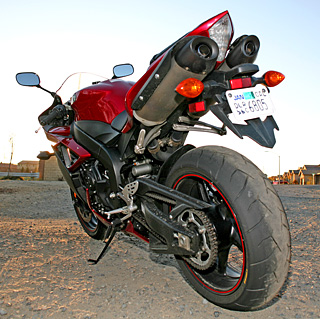
Since I qualified the last paragraph in terms of track use, I’m sure you are already expecting a “but”. The problem for street riding is the new R1’s ridiculously tall gearing. With a first gear that runs just past an indicated 100mph (!!), the R1’s gear ratios are far too track-biased to not be a hindrance in street use. The way the bike is geared, if you’re riding responsibly it’s difficult to get into the rev range where real power is being produced. Of course, even though the YCC-T actually makes smooth throttle inputs easier in first gear (this may be the reason for the surprisingly stiff throttle return spring), anyone other than the most experienced riders is not going to feel comfortable attacking a 60mph canyon road in first gear (too much chance that a bump mid-corner could inadvertently cause the rider to jerk the throttle and be high-sided). This is a bike with an awesome engine that feels merely OK on the street, because it is rare that you rev it up to “awesome”. I’m sure most owners will immediately change out their sprockets to lower the gearing, but that could cause a decrease in freeway mileage.
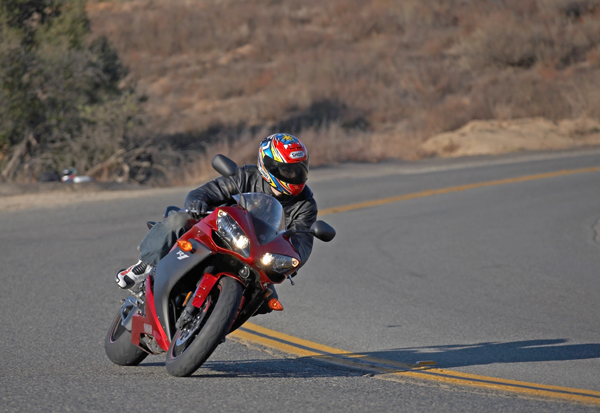
Some of our testers also felt that the vibration produced when the new R1 is running above 7k rpm was “intrusive [and] buzzy…”, although personally it didn’t bother me, nor did I experience numb hands or feet while riding the R1. Maybe this has to do with a difference in body weight? Or perhaps that tester had spent the last few months on smoother-running bikes than I had.
We all agreed that the transmission produced a noticeable ‘clunk’ noise (and a slight lurch) when shifting from neutral to first – one tester speculated this might have something to do with the uber-tall first gear. Other than that clunk, I found the transmission to be a willing partner, and clutchless up-shifts were accepted easily, without excessive effort or noise. Faster riders felt the slipper clutch could have been set-up more aggressively, deciding that it allowed too much engine braking before beginning to slip. Fortunately, there’s an easy solution to this (although we didn’t have a chance to test it) – removing one spring from the slipper mechanism allows it to activate earlier. Less experienced riders, on the other hand, found the R1’s level of engine braking perfectly acceptable and just enough to allow them to use it to help with weight transfer on turn-in. The difference in opinion likely comes from the fact that the faster riders spent more time in the far reaches of the tachometer’s sweep, and closing the throttle at 13k rpm will always produce more engine braking than closing it at 9k.
The feel of the chassis and suspension will be familiar to those who have ridden the latest R6 – now more than ever, Yamaha’s sportbikes have their own distinct character. Precision is the name of the game here, with the rider feeling like he can place the front wheel’s contact patch exactly where he wants in each corner. The well-balanced chassis is always confidence-inspiring, and despite its precise responses never gave a hint of instability. For aggressive corner-carving in the canyons or on the racetrack, the new R1 is a superb mount that never leaves the rider wanting more in terms of its ability to carry huge corner speeds while instilling the confidence that there’s still more left.
Perhaps the most impressive aspect of the new R1’s handling is its ability to change direction like a 600 while still feeling planted and stable. Amazing.
The R1’s suspension isn’t perfect, however, as you’ll learn the first time you head out for a freeway commute or a quick buzz down to the nearest Taco Bell for dinner (yeah, I live in a bachelor pad). Both the fork and shock are very firmly sprung and damped, and although improvements in ride quality can be made through adjusting the damping, you’ll never achieve anything you could call ‘soft’. The heavier a rider is, the less this will bother him – one tester massing around 185lbs called the ride ‘controlled but very firm’, while the 135lbs author found it to be sometimes punishing to his kidneys, especially over sharp-edged bumps (whether one big bump or a succession of small ones). So if you weigh less than 150lbs, consider yourself warned as to the ride quality of the R1 in daily use. To some, this is an acceptable trade-off for more ability on the track – it all depends on the rider.
The new six-piston caliper front brakes provide great power and feel, delivering linear stopping power and excellent fade resistance. Some testers, however, wished for more aggressive initial bite, and all of us agreed that the force required at the lever to induce heavy braking was somewhat excessive. A tradeoff, perhaps, of great feel.
Pirelli Corsas are found on the rubber side of half the US-bound R1s, and as usual these tires were willing partners in anything we chose to subject our R1 test unit to. The Corsas Yamaha is using on the R1 are claimed to be specifically-designed for this bike, using different materials that make them lighter than the off-the-shelf items.
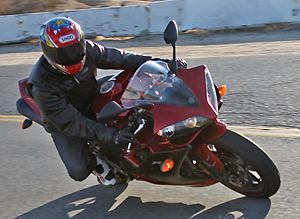
The ergonomics of the new R1 are not quite as racetrack-oriented (read ‘severe’) as the bike’s suspension, but you certainly won’t mistake it for a Honda VFR once you’re in the riding position. The footpeg position is excellent, high enough to provide ample ground clearance without being so high as to cause bad leg cramps. The bars are wide enough to provide good leverage, but the bar-to-seat relationship forces the rider to use some leg strength supporting his upper-body weight or else end up with a fair amount of weight on his wrists.
The windscreen is extremely low and heavily raked back, providing very little wind protection unless you tuck in like a racer. The tank is narrow enough where it joins the seat unit to make side-to-side transitions easy on the rider, and the back of the tank provides good support under heavy braking.
One complaint is the excessive amount of heat venting from the fairing onto the rider’s lower legs. I noticed the same problem with the 2006 R6, and I suspect it is a result of the catalytic converters, which are designed to contain heat as they are most efficient at stripping the exhaust gas of pollutants when they are very hot. In the future, it seems that all production bikes will be fitted with these catalysts, so we hope that bike designers will focus more on getting that heat out and away from the rider, as it can be quite uncomfortable on a hot day – if you’re commuting on an R1, expect to spend the morning at your office with completely sweat-soaked socks – I know I did.
The instrument panel is layed out clearly and is easy to read, although the dark-blue back lighting doesn’t seem to be the best choice of color – a lighter, brighter blue would make the black numerals easier to read at night. The R1 features Yamaha’s innovative ‘fuel trip meter’, which activates automatically when the fuel light goes on – useful, since hard riding will return sub-30mpg mileage (freeway commuting worked out to a more reasonable 40-56mpg).
The R1’s headlights are extremely effective, one tester calling them ‘the best sportbike headlights by far’. Not quite up to the standard of the huge spotlights on our long-term Kawasaki ZX-14, which lights up the road ahead like a rally car, but close enough that we have to give kudos to Yamaha for concentrating on a crucial and oft-ignored detail that improves rider safety and confidence when riding at night.
After making my typical “beauty is in the eye of the beholder” disclaimer, I will say that in my opinion, the new R1 is a step back in some ways from the previous bike – the new swingarm, for example, is far less elegant than the old design. Form over function, though, is a good motto, and the new chassis design certainly performs far better than its already-competent predecessor.
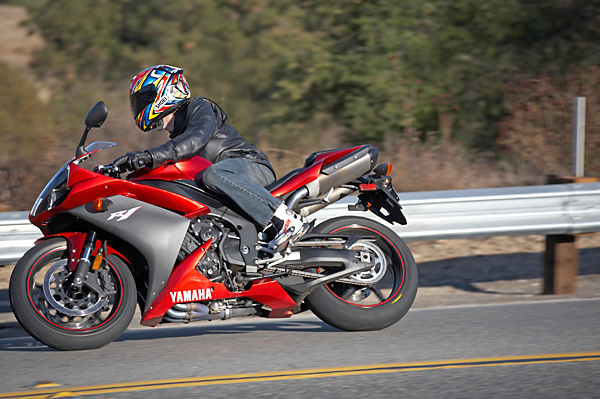
So what’s the end result? For street use, the R1 can be by turns inspiring and maddening – inspiring when you hit a sequence of fast sweepers and feel yourself carrying corner speed that makes you feel like a superbike racer, maddening when you’re sitting at a stoplight and the catalysts are cooking your lower legs, then you try to take off and have to use drag-racer-like high rpms and tons of clutch slippage to overcome that ridiculously tall first gear. As I found at Laguna Seca in my First Ride, however, it all comes together on the track, making the R1 quite possibly one of the easiest-to-ride and most smile-inducing liter bikes I’ve ever hustled around a racetrack. Can you live with the day-to-day drawbacks while waiting to enjoy it on the track or in the canyons, though? That’s a decision that depends entirely on your priorities as a rider.





